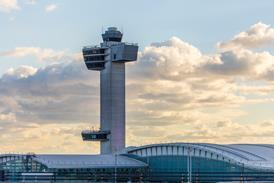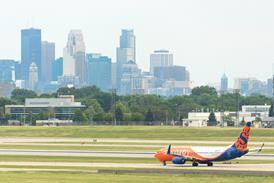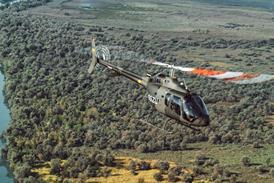When insurers announced they would cancel war risk cover for airlines in the week after 11 September, it opened an impassioned debate which is still to be resolved
On 17 September, the world's airlines were trying to regroup from the terrorist attacks of six days before, with those in the USA still trying to get their aircraft back in position after a two-day grounding. The last thing carriers were prepared for was notification by their insurer that it would invoke its right to cancel its war coverage insurance in seven days.
Only months before, war risk cover was seen as so inconsequential that insurance companies tacked it on to the bottom of their "all-risk" aviation policies for what amounted to about 2¢ per passenger. Now, it threatened to halt flying by every major airline on the planet.
The statement by the insurers that by 24 September they would withdraw the AVN 52c cover that protects airlines from passenger and third-party liability arising from acts of war had dire implications for the carriers. Although the insurers offered new policies in AVN 52's stead which would provide cover for third-party liability up to $50 million, this amount fell well below the $1 billion minimum required for airlines by aircraft lessors and banks.
Furthermore, even that limited coverage was offered with a price tag of unprecedented size: a four-fold increase to $1.25 per enplaned passenger, of which there are over 1.5 billion worldwide each year. In the USA alone, this will represent new annual costs of between $800 million and $1 billion.
A complete grounding appeared imminent, leading aggrieved airline executives to complain that the insurance community would finish what the terrorists had started.
However, after intensive, 24-hour lobbying by the airlines and their trade groups, most of the world's governments agreed to offer coverage over the $50 million per aircraft being provided by the insurance industry. However, these supplemental policies - which come at the decidedly more affordable cost of $7.50 per departure - are short-term measures, as governments everywhere say that ultimately it must be the market and not them that provides airlines with insurance.
Although the cover - initially due to expire on 20 March - was extended by most governments for an additional 60 days, nobody views this period as a two-month vacation, especially as most seem to feel that further extensions of government cover are at best unlikely.
Indeed, it appears certain that the next two months will go a long way towards determining the future shape of war risk insurance for the airlines. Unsurprisingly, the two sides of the equation - the insurers and the airlines - have vastly different views on how the sector should look moving forward.
The airlines have taken great umbrage with the insurance community's use of the seven-day cancellation policy, which they feel put their backs against the wall for the second time in a week. The bad feelings are compounded by their belief that the $1.25 surcharge is excessive. Christopher Duncan, vice-president and chief risk officer at Delta Air Lines, speaks for carriers everywhere when he says: "We're in a fight for our survival and the insurance industry is not helping us."
As a direct consequence, most airlines and airline trade groups are advocating a new system whereby they, with government support, would take over liability insurance.
For their part, the insurers believe that the market (in other words, themselves), and not government, should provide insurance services to the airlines. Furthermore, they believe all parties should get behind the insurance companies and accept as inevitable the idea of large premium increases. Without these, they say, insurance companies will be unable to attract the capital necessary to provide aviation cover.
On the airline side, insurance was never a terribly high-profile item. That plainly has changed, not only for its ability to ground the fleet, but also for its implications on costs. At a time when all carriers are desperately slashing costs, an extra $800 million in expenditure captures attention at the highest levels.
American Airlines saw its insurance costs rise 350% in the last quarter of 2001. Treasurer James Beer says, at that point, insurance is taken off the chief financial officer's desk and put on the chief executive's. Indeed, the surcharge has become the focal issue on which everybody has an opinion - often at odds with everyone else's. Even the rationale behind it provokes an argument.
The levy was ostensibly put forward as a mechanism by which the insurance industry could recoup anticipated third-party losses from 11 September, which were not pre-funded. However, Jonathan Palmer-Brown, chairman of the UK-based insurance brokerage Aon, and current chair of the London Market Brokers Committee, contends that airlines may end up not being held responsible for third-party liability damages. "Under FAA regulations, the airlines weren't negligent. The acts of 11 September were a sea change in the way hijackings occur," he says. "If someone steals your car, are you liable for what they do with it?"
Even if the airlines are held accountable for the damage their aircraft did to people and property at the World Trade Center and Pentagon, how much they would owe remains uncertain. Duncan at Delta is not alone in his belief that "all the cost of 11 September should not be borne by the airlines". Even if it were, he adds, the damages would mean likely costs equal to about 35¢ per passenger, not $1.25. And this figure falls to 18¢ per passenger if the airlines are deemed liable for half the damages - an outcome he feels is much more likely.
Whatever the ultimate answer, it is not likely to surface for some time. Litigation in such cases usually drags on for years - often as much as a decade - before a decision is given. Carriers are naturally not keen to continue paying the surcharge until resolution is attained.
Therefore, the airline industry is busy trying to design new ways of obtaining third-party war risk cover without meeting the demands of the insurers.
ICAO has been working with brokers to establish a not-for-profit mutual fund to provide this essential cover. Under this plan, participating states would guarantee the risk and the airlines collect a 50¢ per passenger levy to capitalise it. The fund will have to be voted into existence by ICAO member countries, which is not inevitable. In any case, it promises to be a lengthy process.
Equitime cometh?
Meanwhile, in the USA, industry trade group the Air Transport Association, in co-operation with the Department of Transportation and insurer Marsh, proposes the creation of another captive company to provide third-party liability war risk cover for airlines.
The Equitime plan - named after the point in flight at which the risk of going forward is equal to the risk in returning - calls for around 75 US carriers to start a company that will sell war risk coverage and collect premiums. Initially, the US government would retain most of the risk, but as premiums are collected the government's share of the risk would diminish to the point that all Equitime's capital had come from the airlines.
Assuming no further terrorist attacks or similar catastrophes, the savings to the airlines would be substantial. Brian Harris, analyst at Salomon Smith Barney, says that at 50-70¢ per passenger, the airlines would immediately save $400 million from what they currently pay under the government/market programme and up to $1 billion over what the market alone currently is offering. After several years with no claims, they anticipate their continued war risk liability premiums would fall to around 20¢ per enplanement.
The potential value to the airlines of Equitime (which Duncan says would not preclude participation in the ICAO plan, should it get off the ground) is further enhanced by its featuring a cancellation notification period of at least 90 days, instead of the current seven.
Parallel to the ATA's efforts with Equitime are those by the Association of European Airlines, which is currently trying to build support in Brussels for a similar proposal - "Eurotime."
Unsurprisingly, the insurance community's reaction to Equitime and its brethren is negative. On philosophical grounds, many, like Nick Brown, vice-president with the aviation division at US insurance giant AIG, believe that the industry will be best served when insurance once more becomes the domain of the market, and not the government.
AIG has offered a policy of war risk coverage that meets the minimum insurance requirements of lessors and regulators. Salomon Smith Barney's Harris estimates the price of this package - which affords the policyholder $1 billion of cover, at least $500 million less than Equitime proposes to offer - to be about the equivalent of $2.25 per enplanement (in its first incarnation it was approximately $3.10 per enplaned passenger).
The airlines contend that the insurers' interests are strictly monetary, with Duncan saying that the insurance industry's objection to Equitime is solely down to the surcharge. With this charge, he says, "they can demand and receive massive premiums". Palmer-Brown agrees. "If I were an insurance company [receiving these funds], I also would be reluctant to give them up," he says.
The nearly constant reiteration of such sentiments has the insurance community feeling that it is become an all-purpose whipping post. "We definitely have become the airline industry's bête noire," says AIG's Brown.
Insurer's defence
What's more, they feel the lion's share of the criticism is unfair. Peter Butler of Global Aerospace and chairman of the trade group Aviation Insurance Offices' Association, for instance, finds airline claims of surprise incredible when insurers exercised their seven-day notification of cancellation rights. They also hold that the airlines must understand that they are facing serious premium rises, because the insurance industry has serious profitability problems of its own, problems that existed well before last September.
After years of claims surpassing premiums, aviation has been a blight on the balance sheet of both insurers and re-insurers.
Thomas Thomsen, aviation department head at leading reinsurer Munich RE, puts it bluntly. "We're in bad shape," he says. "The time of fun and games in the aviation insurance market is over and a lot of insurance company chief executives will want to leave the field."
The insurance market has known for years that correction is sorely needed. After a lengthy period of high capacity pushing down premiums, a move was under way to bring rates up by 25-50% and correct the $2.5 billion gap between claims and premium revenue. Airlines, understanding that their previous rates were unsustainable, did not object and even signed up for early renewals, so as to lock in rates that seemed to be rising fast. This was the situation up to 10 September.
The next day, of course, what will undoubtedly be the biggest insurance disaster in history occured. The previous champion was 1992's Hurricane Andrew, which cost underwriters $19.6 billion. The loss for 11 September will likely be between two and four times that much.
Therefore it makes sense that the insurers would object to any intervention that would prevent them from receiving the $1.25 surcharge, which they seem to see as their due, not only for past losses, but also for future risks. Graham Nichols, director with the Westminster Aviation Insurance Group, speaks for his industry in saying: "The surcharge is not just to take care of the past. We still live in a dangerous world and the surcharge is equally meant [to guard against] risks we face today."
Butler agrees. "To see the airlines as uniquely in crisis is wrong," he says. "We need to solve our problems together. You don't solve one industry's problems by pulling another into bankruptcy."
In addition to lives and property, among the things most in need of repair post-11 September is the relationship between the insurers and their airline clients. Reiner Siebert, risk and insurance manager with Virgin Atlantic, illustrated the lack of empathy between the two when he recounted one insurer comparing the cost to airlines of the surcharge with that of providing free soft drinks and another suggesting that airlines were ripping off their customers.
Butler characterises the relationship as being marked by mutual respect and says that the airlines must, if begrudgingly, acknowledge that the insurance market has continued to respond to their needs. However, he also concedes that "there are relationships that need to be rebuilt, there is a lot of rebuilding to be done in future."
The insurers appear to be laying part of the blame for the current poor relations at the feet of the intermediary between the two - the brokers. Westminster Aviation's Nichols terms as "rubbish" the suggestion by Palmer-Brown that the airlines might not be liable for the third-party damage caused on 11 September. Then why did he say it? "The brokers," Peter Butler explains, "feel they must appear to be looking out for their clients' best interests."
Repairing the damage
Perhaps a confluence of interests is the only way these two adversaries can patch up their relationship. Happily, one may exist. There is growing belief that it is in both parties' interests to have terrorism removed from the list of eventualities for which the market must provide insurance. As airlines are obviously happy to have both a cost and a responsibility removed from their portfolio, Ralf Oelssner, Lufthansa's director of corporate insurance, expresses a popular notion when he says that "terrorism is not [exclusively] an airline problem. Our long-term goal is indemnity for airlines against terrorism attacks."
From the insurer perspective, although this course would remove a premium stream, some feel that the risks associated with offering third-party liability are greater than the benefits accruing from the added revenue. This view also has an audience with the re-insurance community, as evidenced by Munich RE's Thomsen statement that "if the size of the claim is not predictable, we cannot calculate a premium and we will not cover it". As a consequence, both parties may join hands to lobby government to re-write the rules.
Perhaps this shared goal will bring the two closer together. Tim Liddiard, executive director of the Heath Lambert Group brokerage's aviation division, describes the state they should work towards as "a point where insurance costs are not so onerous that airlines cannot feasibly fly, but that are high enough that the insurance market is viable and is prepared for another disaster".
Both sides should hope so. With a $50 million third-party suit already having been launched by the husband of a financial manager killed in the World Trade Center, the clock is ticking.
Source: Airline Business























